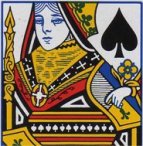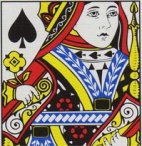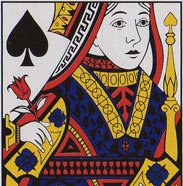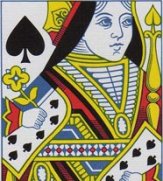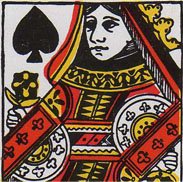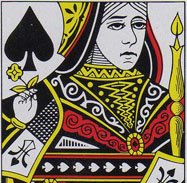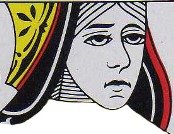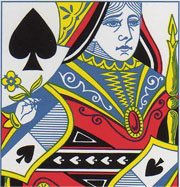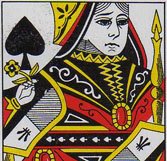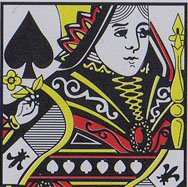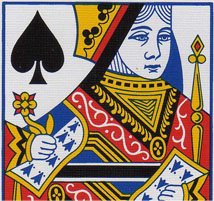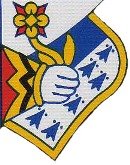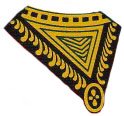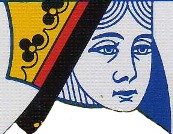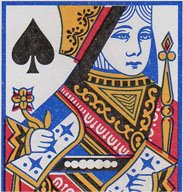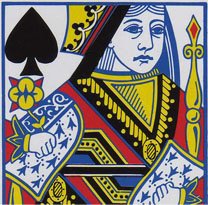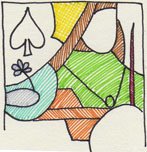Cards have long been used in fortune-telling (although not so long as they’ve been used in game-playing). The standard French (aka Anglo-American) deck of 52 playing cards in 4 suits is closely related to the traditional Tarot Minor Arcana, which consists of 56 cards in 4 suits. Beyond iconographical conventions, the only differences between the two decks are a fourth court card given to each suit (a Knight, who places between the Queen and Page, aka Jack), and the Latin naming of the suits (that is Batons – aka Wands, Staves, Staffs, Rods – for Clubs; Pentacles – aka Coins, Disks – for Diamonds; Cups – aka Chalices, Goblets, Cauldrons – for Hearts; and Swords – aka Blades, Daggers – for Spades).
Each card in the Minor Arcana draws significance from its rank and its suit and holds unique significance of its own. For example, it is helpful to think of the Queen of Swords as not merely the Queen of Swords – an individual – but also as a Sword and as a Queen.
The suit of Swords is represented by the intangible and unseen, yet keenly felt, element of air; and the Gemini, Libra, and Aquarius star signs. Sword cards symbolize thought, reason, communication, and the mind in all its creative and destructive glory; and they also symbolize the forces of truth and justice, both of which can function as sharp and penetrating double-edged challenges in our lives. In a spread, Sword cards can represent a person or personality phase characterized by strength, authority, courage, temperance, and ambition on the one hand, or arrogance, aloofness, judgement, and the need for control on the other; they can also represent an involvement in a formal arrangement, or in the legal, political, or judicial systems; or they can represent the querent’s mentality – his or her ability to learn, remember, analyse, and determine, or his or her perceptions of, biases against, or insights into the issue at hand.
Queens are represented by the element of water. They symbolize creative force, and signify growth, development, and realization. It is often argued that queens, like all court cards, are most likely to represent actual people, but they can also represent an aspect of a person’s personality, a personality phase, an event, an engagement, etc.
The Queen of Swords is perceptive, intuitive, analytical, cunning, and astute. She has a graceful manner and a dry sense of humour. She is intelligent and widely learned, and makes a great conversationalist; but she is also private and reserved, and she does not take lovers or friends lightly, without first developing a secure foundation of trust and intimacy. To her loved ones, she is loyal and honest, and her wise and measured vision of the world is of great value to those in need of support. If she has been betrayed or abandoned, or otherwise feels insecure and vulnerable, she will be fiercely self-protective, solitary, and focused on survival: her attitude in this case will be cold, judgemental, cynical, unforgiving, and even manipulative.
It seems to me that queens also bear a call to action. Of course, to determine the contents of this call, the Queen of Swords must be interpreted in the context of the spread. Perhaps the querent must adopt aspects of the Queen’s personality for the development of a written or verbal project, or a legal or formal engagement; or to help a friend in need of support. Perhaps the querent has adopted certain negative aspects of the Queen’s personality in response to a trauma in her or his life, and must now shed these characteristics and focus on healing his or her wounds. Perhaps the Queen represents a person the querent knows who ought to be understood and befriended, or else acknowledged as a destructive force and removed from his or her life. Etc.
In card play, the Queen of Spades sometimes holds a negative significance. In the game of Hearts, she is the Black Lady, worth negative 15 points; in Eights, she is the pick-up-five, the worst card for the opponent at your right to play; and in Gong Zhu, she is the pig, to be avoided at all costs.
